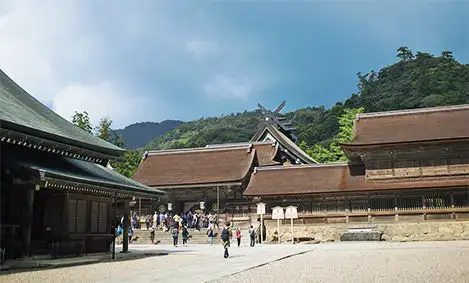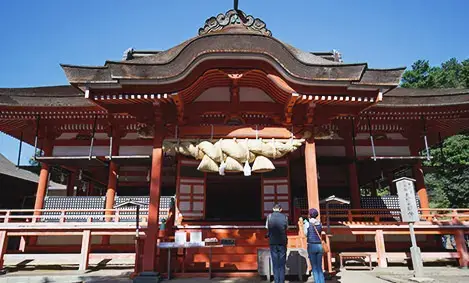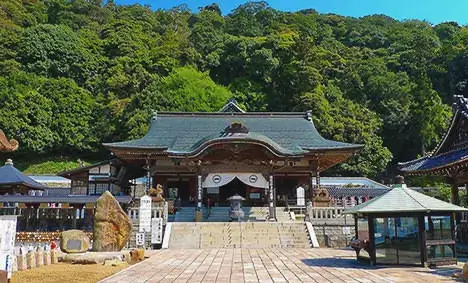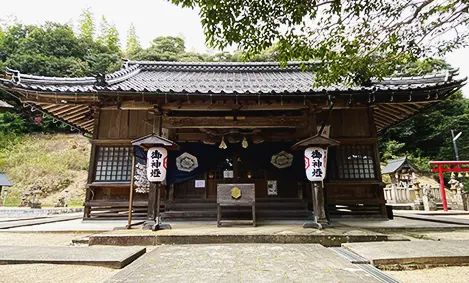神社仏閣Shrines and Temples in Izumo
Explore the most ancient shrine in Japan
Many of the shrines in the Izumo area figure prominently in these ancient myths and the beginnings of Japanese culture. None is more famous than Izumo Taisha Grand Shrine. All of Japan's Shinto deities come here during the tenth month of the old lunar calendar.

出雲大社
Izumo Taisha Grand Shrine Explore the most ancient shrine in Japan.
Izumo Taisha Grand Shrine is known as the shrine where myriad deities from all over Japan gather and hold a meeting once every year. The main deity is known as the god of matchmaking. The main hall of the shrine is designated as a national treasure.

The Sacred Grounds Where Gods Gather
It is said that long ago, the god Yatsukamizuomitsu no Mikoto (八束水臣津野命) found large plots of unused land on the Asian continent and pulled them across the Sea of Japan, joining them with Izumo Province - as this area was known at the time - and expanding the country significantly.
As a result, Izumo became known as the "Land of the Gods" and the "Land of Mythology" and is home to Izumo Taisha Grand Shrine, which is the central point of Japan's most ancient myths, ruins, and shrines.
Countless festivities and traditions that pertain to Japanese mythology can still be experienced in Izumo today. Festivals, traditional food and sake, and various cultural aspects of ancient Japan continue to thrive in Izumo.

Izumo Taisha Grand Shrine Honden (Inner Shrine)
According to the Kojiki and Nihonshoki, Izumo Taisha Grand Shrine originated when the sun goddess Amaterasu Omikami created a large palace with pillars set deep into a rock in the abyss for Okuninushi no Okami on the occasion of his kuni-yuzuri (transfer of the land).
The current inner shrine, measuring 24 meters in height, was built in 1744, and designated as a national treasure in 1952.

Izumo Taisha Grand Shrine Front Shrine (Worship Hall)
After passing under the do-torii (copper shrine gate), you will have a direct view of the front shrine.
Measuring 13.5 meters in height and made of Japanese cypress, it was reconstructed in 1959.
The front shrine building is positioned a little off center to the left, which you will notice when standing beneath the shrine gate at the center.
This is to enable visitors to have a view of the inner shrine roof.

日御碕神社
Hinomisaki Shrine Important cultural asset
It was built by Shogun Tokugawa Iemitsu in early Edo Period. The architectural style is called gongenzukuri and the shrine is beautifully colored in vermillion-lacquer.

Enshrined Deities are Amaterasu and Susano.
It’s an ancient shrine, and it features two honden (main sanctuaries) inside.
The honden facing the entrance is called Hi-Shizumi-no-Miya, and the deity enshrined within is Amaterasu Omikami.
The other honden on the upper hill is called Kami-no-Miya and the deity Susano-no Mikoto is enshrined here.

You can appreciate nature at this shrine.
Walking around the Hinomisaki area around sunset is a gift from nature as the sun sets over Hi-Shizumi-no-Miya.
Hinomisaki Shrine is a 20-minute drive to the northwest from Izumo Taisha Grand Shine. It is a beautiful ocean-view drive.
Related Experiences

一畑薬師
Ichibata Yakushi Temple A superb view from the precincts where you can see Izumo myths
This temple is at the top of Mount Ichibata, which is about 200 meters tall. About 1,300 stone steps are set up from the foot of the mountain to this temple, but cars and buses can approach the temple using a climbing road.

Yakushi Nyorai, the Buddha of medicine and healing.
This temple, perched on a mountaintop in Shimane Prefecture, is the equivalent of a Japanese Lourdes for those with any kind of eye complaint, with hundreds of thousands of pilgrims making their way there every year.

Countless Buddha statues
84,000 statues of Yakushi Nyorai, donated by pilgrims and supporters, are well worth a view, as are 108 stone lanterns, also donations.
In Buddhism, 108 is believed to be the number of worldly desires.

The healer of eyes
This temple is a Rinzai Buddhist temple located in Izumo City. It is the chief temple of the Ichibata Yakushi school of Rinzai Buddhism.
Praying at the temple is said to help people recover from eye ailments, and Yakushi Nyorai, the “healer of eyes” has attracted large numbers of worshippers for many centuries.
Related Experiences

須佐神社
Susa Shrine Walking through Susa Jinja Shrine, where the god Susanoo sleeps, we are greeted by a 1300 year-old giant cedar tree.
Susa Jinja Shrine, which is dedicated to Susanoo, one of the most famous gods in Japan, is a famed spiritual power spot as well. Surrounded by the forest, an air of mystery emanates from the shrine's grounds.

佐香神社
Saka Shrine Visiting the shrine of the god of sake brewing, Kusunokami. This shrine has appeared in ancient historical texts.
The Izumo region and traditional Japanese sake are deeply connected and share a long history. Saka Jinja, a shrine dedicated to the god of sake brewing, was featured in a historical text from the year 733 A.D. called "Izumonokunifudoki."

![[object Object]](/img/exp/vol2/mv@0.33x.webp)
![[object Object]](/img/exp/vol4/mv@0.33x.webp)
![[object Object]](/img/exp/vol13/1@0.33x.webp)
![[object Object]](/img/exp/vol14/1@0.33x.webp)